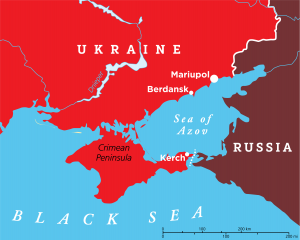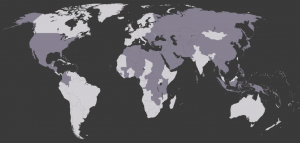UKRAINE-RUSSIA: HOSTILITIES AT A NEW AND DANGEROUS STAGE
WHY IT’S IMPORTANT
 With this maritime incident, a threshold has been crossed and the prospect that events will remain a fleeting, short-term crisis fades with each passing day.
With this maritime incident, a threshold has been crossed and the prospect that events will remain a fleeting, short-term crisis fades with each passing day.
Located near the front lines of the armed conflict between Ukrainian regulars and Moscow-supported Russians separatists, loss of access to Mariupol (and the nearby port of Berdansk), would be catastrophic to Ukraine’s struggling economy.
The events mark the first time Russia has openly admitted a direct conflict with regular Ukrainian forces. Since the 2014 annexation of Crimea, Russia has consistently — and in the face of repeatedly documented evidence — said that forces fighting in Eastern Ukraine were simply locals fighting for self-determination, or aided by Russian “volunteers”.
BACKGROUND
On 25 November, Russia dramatically upped the ante in its undeclared war with Ukraine, capturing three Ukrainian tugboat-type naval vessels in the Sea of Azov, detaining 26 Ukrainian sailors, and blocking access to one of Ukraine’s major seaport cities, Mariupol. The events, in which Ukraine alleges Russian vessels opened fire, pose the specter of a larger, more openly declared war in a conflict that has killed more than 10,300 since April 2014.
Moscow says the captured vessels violated its temporary regime imposed against sea traffic in the Strait of Kerch, which connects the Sea of Azov to the Black Sea. Russia has threatened to criminally charge the detained Ukrainian sailors for crossing “Russian” maritime borders.
According to an international maritime agreement, Ukraine and Russia share rights to the Sea of Azov, but it is de facto controlled by Russian vessels patrolling the Strait of Kerch. Even after Moscow’s 2014 annexation of Crimea, in which it captured, disabled or sank a significant number of Ukrainian navy vessels, the agreement has generally been respected, preserving Ukrainian access to the key industrial port city of Mariupol. Located near the front lines of the armed conflict between Ukrainian regulars and Moscow-supported Russians separatists, loss of access to Mariupol (and the nearby port of Berdansk), would be catastrophic to Ukraine’s struggling economy.
Tensions have been simmering since May 2018, when Russia connected its mainland to Ukraine via a 24-km long bridge whose low height impedes access for larger vessels to the Sea of Azov. Tensions escalated dramatically, with ominous warnings from Moscow; ten days ago, Moscow accused Ukraine of “provocations” and on 22 November, Russia warned Ukraine about “unilateral actions” in the area.
UKRAINE’S “FULL BATTLE READINESS”, NATO & THE UN
In response, on 26 November Ukrainian President Petro Poroshenko ordered Ukrainian forces to full battle readiness and on 25 November, the Ukrainian Parliament, the Verkhovna Rada, approved a 30-day State of Emergency in 10 regions adjacent to Russia or coastal areas. Even if extended, the State of Emergency, whose real effects are murky, are unlikely to, on its face, affect the politics or scheduling of Presidential elections planned for 31 March, in which the President trails in polls. His main opponent, Yuliana Timoshenko, is a nationalist firebrand and largely viewed as more radical and unpredictable than Poroshenko.
NATO Chief Jens Stoltenberg strongly condemned the Russian actions, as did the EU delegation to the UN Security Council, the US, Canada and several other European countries. As the UN Security Council convened a session on November 25 to discuss the escalating crisis, a number of top Ukrainian politicians called for severing diplomatic relations with Russia.
Russia levied all blame on Ukraine, calling the situation a “provocation” aimed at discrediting Russia and pitting Moscow against NATO, where Ukraine seeks full membership. Russia urgently called back to Moscow Foreign Minister Sergei Lavrov, who was attending a UNESCO meeting.
Kyiv on 26 November called for tougher sanctions on Russia by the EU; some US congressional figures called on President Trump to do the same; and U.S. Air Command said it had dispatched intelligence-gathering planes to the area from a base in Greece.
STRATEGIC IMPLICATIONS: MARIUPOL
The Azov Sea port city of Mariupol has been a strategic focal point of the five-year war. Its status as a “fort-post” or “front-line barricade” has grown over time, correlating with increasingly frequent news bulletins from the Kyiv government about fresh recruits and security personnel being dispatched to the city and its environs. The city is also an energy hub, with critical coal deliveries arriving regularly by sea for its five large metallurgical plants and other outdated coal-fired power facilities (delivery by rail remains prohibitively expensive and risks sabotage).
The second largest city in the historically industrial oblast of Donetsk, Mariupol is roughly 80 percent native Russian-speaking. But after being “occupied” for several months in 2014 by Moscow-backed irregular units from the so-called Donetsk People’s Republic (DNR), many of whom engaged in looting or excesses, sympathy for Russia sharply decreased. The late-2014 reestablishment of Kyiv control stabilized the situation but a significant outflow of population continued as the economy and security situation deteriorated. Since then, pro-Moscow forces have regularly conducted artillery shelling of close-by areas.
There is a palpable sense of siege in Mariupol: every 100 meters or so, painted sidewalks direct pedestrians to the nearest “bomb shelter” and local officials talk of tanks brought in from Russia and hidden in forests near the border. Public speculation and media reporting on Russia’s alleged aim of establish a land bridge with annexed Crimea — one that either isolates or goes through the Mariupol area by sea and land — persists.
RUSSIA’S SHIFT & MOTIVATIONS
Since the 2014 annexation of Crimea, Russia has consistently — and in the face of repeatedly documented evidence — said that forces fighting in Eastern Ukraine (units from the so-called “DNR” units and Lugansk People’s Republic (LNR)) were simply locals fighting for self-determination, or aided by Russian “volunteers”, some supposedly on “vacation” from regular duties.
However, this week marks the first time Russia has openly admitted a direct conflict with regular Ukrainian forces. While seemingly semantic, it is a significant acknowledgement that Russia is in an official armed conflict with Ukraine and marks an entirely new chapter in a conflict fraught with unpredictable consequences.
The incident follows several weeks of seething Russian responses to new western sanctions over the Skripal poisoning, alleged election meddling and cyber-attack allegations, as well as the Trump administration’s announcement that it intends to pull out of the Intermediate Nuclear Forces (INF) treaty, in effect since 1987. In August, Russian Prime Minister Dmitry Medvedev had warned that Moscow would consider any new U.S. sanctions as a “declaration of economic war” and would retaliate “economically, politically or, if needed, by other means”. Upping the ante in Ukraine and other countries in Russia’s “near abroad”, including other regions of the former Soviet Union, would appear to be among low-hanging retaliatory fruit as counter-measures.
Some have also pointed to Putin’s plunging approval ratings as stimulus for measures aimed at distraction: recent polls put Putin’s approval ratings at an all-time low (55 percent, down from as high as the 80s). Economic woes are also taking a toll; the Russian Ruble and the Ukrainian Hryvna have both lost ground against the Euro and U.S. Dollar. But even with slipping poll numbers, the Kremlin retains a firm grip on power and faces no well-organized internal opposition as a either check on or motivation for its actions, which are largely self-designed and directed.
WHAT NEXT?
With this maritime incident, a threshold has been crossed and the prospect that events will remain a fleeting, short-term crisis fades with each passing day. A mix of domestic and international factors — some basic, some more complex — continue to motivate Russia and Ukraine to probe the reaction of other stakeholders, including domestic political constituencies, multilateral partners and existential rivals. Whether, how and where the situation leads will have significant implications for Russia’s geopolitical agenda, Ukraine’s supporters and allies and its sovereign and economic viability.
Ukraine would seem to have played most of its options diplomatically. It has already secured verbal support from key actors and allies, and even some arms sales, but its position remains weaker and a full-throttled military response in support of Ukraine is unlikely.
Moscow could back down and hope for reciprocal de-escalation and a reward for seeming “magnanimous”, particularly in the case of U.S. President Trump, who was hesitant to firmly denounce Moscow over the situation in Ukraine on Monday. Russia could also count on dissension between European and Western actors over the situation, using it to increase active military operations in Ukraine as a “price” for sanctions and isolation.

